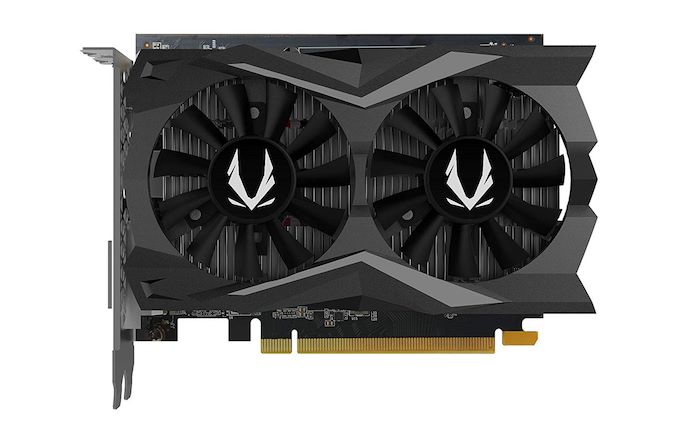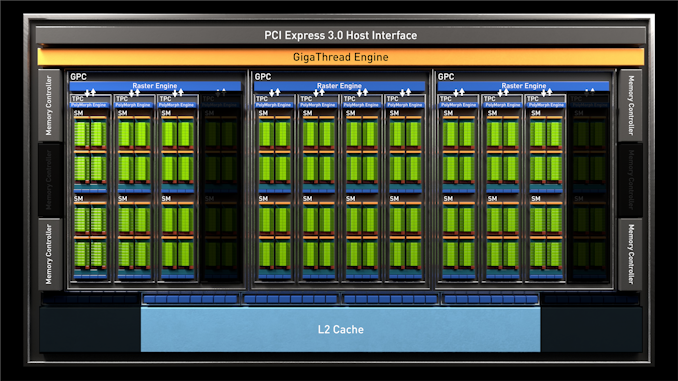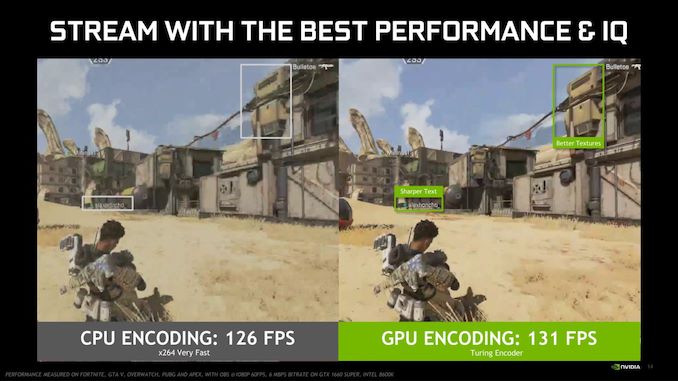The NVIDIA GeForce GTX 1650 Super Review, Feat. Zotac Gaming: Bringing Balance To 1080p
by Ryan Smith on December 20, 2019 9:00 AM EST
Bringing 2019 to a close in the GPU space, we have one final video card review for the year: NVIDIA’s GeForce GTX 1650 Super. The last of the company’s mid-generation kicker cards to refresh the lineup in the second-half of 2019, the GTX 1650 Super is designed to shore up NVIDIA’s position in the sub-$200 video card market, offering solid performance for 1080p gaming without breaking the bank. At the same time, it’s also NVIDIA’s response to AMD’s new Radeon RX 5500 XT series of cards, which having landed last week, significantly outperform the original GTX 1650.
Like the other Super cards, these refresh parts serve to shore up NVIDIA’s competitive positioning against AMD’s Radeon RX 5000 series cards, offering improved performance-per-dollar at every tier. NVIDIA has taken some flak for uncompetitive pricing, and this is not unearned. And it goes perhaps most for the original GTX 1650, which although is easily the best 75W card on the market, it’s always been surpassed in value by AMD’s cards; first the last-generation Polaris cards, and now the new Navi cards. So with the GTX 1650 Super, NVIDIA and its partners finally get a chance to rectify this with a more competitive part, that while no longer fitting into the original’s 75W niche, offers better performance all around.
| NVIDIA GeForce Specification Comparison | ||||||
| GTX 1660 | GTX 1650 Super | GTX 1650 | GTX 1050 Ti | |||
| CUDA Cores | 1408 | 1280 | 896 | 768 | ||
| ROPs | 48 | 32 | 32 | 32 | ||
| Core Clock | 1530MHz | 1530MHz | 1485MHz | 1290MHz | ||
| Boost Clock | 1785MHz | 1725MHz | 1665MHz | 1392MHz | ||
| Memory Clock | 8Gbps GDDR5 | 12Gbps GDDR6 | 8Gbps GDDR5 | 7Gbps GDDR5 | ||
| Memory Bus Width | 192-bit | 128-bit | 128-bit | 128-bit | ||
| VRAM | 6GB | 4GB | 4GB | 4GB | ||
| Single Precision Perf. | 5 TFLOPS | 4.4 TFLOPS | 3 TFLOPS | 2.1 TFLOPS | ||
| TGP | 120W | 100W | 75W | 75W | ||
| GPU | TU116 (284 mm2) |
TU116 (284 mm2) |
TU117 (200 mm2) |
GP107 (132 mm2) |
||
| Transistor Count | 6.6B | 6.6B | 4.7B | 3.3B | ||
| Architecture | Turing | Turing | Turing | Pascal | ||
| Manufacturing Process | TSMC 12nm "FFN" | TSMC 12nm "FFN" | TSMC 12nm "FFN" | Samsung 14nm | ||
| Launch Date | 03/14/2019 | 11/22/2019 | 04/23/2019 | 10/25/2016 | ||
| Launch Price | $219 | $159 | $149 | $139 | ||
From a pure hardware perspective, perhaps the most interesting thing about the GTX 1650 Super is that, unlike the other Super cards, NVIDIA is giving the new Super card a much bigger jump in performance over its predecessor. With a of 46%, increase in GPU throughput and faster 12Gbps GDDR6 memory, the GTX 1650 Super is much farther ahead of the GTX 1650 than what we saw with October’s GTX 1660 Super launch, relatively speaking.
The single biggest change here is the GPU. While NVIDIA is calling the card a GTX 1650, in practice it’s more like a GTX 1660 LE; NVIDIA has brought in the larger, more powerful TU116 GPU from the GTX 1660 series to fill out this card. There are cost and power consequences to this – the 284mm2 is a very large chip to be selling for $159 – but the payoff is that it gives NVIDIA a lot more SMs and CUDA Cores to work with. Coupled with that is a small bump in clockspeeds, which pushes the on-paper shader/compute throughput numbers up by just over 46%.
Such a large jump in GPU throughput also requires a lot more memory bandwidth to feed the beast. As a result, just like the GTX 1660 Super, the GTX 1650 Super gets the GDDR6 treatment as well. Here NVIDIA is using slightly lower (and lower power) 12Gbps GDDR6, which is attached to the GPU via a neutered 128-bit memory bus. Still, this one change gives the GTX 1650 Super 50% more memory bandwidth than the vanilla GTX 1650, very close to its increase in shader throughput.
Do note, however, that not all aspects of the GPU are being scaled out to the same degree. In particular, the GTX 1650 Super still only has 32 ROPs, with the rest of TU116’s ROPs getting cut off along with its spare memory channels. This means that while the GTX 1650 Super has 46% more shader performance, only has 4% more ROP throughput for pushing pixels. Counterbalancing this to a degree will be the big jump in memory bandwidth, which helps to keep those 32 ROPs well-fed, but at the end of the day the GPU is getting an uneven increase in resources, and gaming performance gains do reflect this at times.
The drawback to all of this, then, is power consumption. While the original GTX 1650 is a 75 Watt card – making it the fastest thing that can be powered solely by a PCIe slot – the Super-sized card is officially a 100 Watt product. This gives up the original GTX 1650’s unique advantage, and it means builders looking for even faster 75W cards won’t get their wish, but it’s the power that pays the cost of the GTX 1650 Super’s higher performance. Traditionally, NVIDIA has held pretty steadfast at 75W for their xx50 cards, but then again at the end of the day, despite the name, this is closer to a lightweight GTX 1660 than it is a GTX 1650.
Speaking of hardware features, besides giving NVIDIA a good deal more in the way of GPU resources to play with, the switch from the TU117 GPU to the TU116 GPU also has one other major ramification that some users will want to pay attention to: video encoding. Unlike TU117, which got the last-generation NVENC Volta video encoder block for die space reasons, TU116 gets the full-fat Turing NVENC video encoder block. Turing’s video encode block has been turning a lot of heads for its level of quality – while not archival grade, it’s competitive with x264 Medium – which is important for streamers. This also led to TU117 and the GTX 1650 being a disappointment in some circles, as an otherwise solid video card was made far less useful for video encoding. So with the GTX 1650 Super, NVIDIA is resolving this in a roundabout way, thanks to the use of the more powerful TU116 GPU.
Product Positioning & The Competition
As is always the case in the lower-end segment of NVIDIA’s product stack, the GTX 1650 Super is a pure virtual launch. This means that NVIDIA hasn’t put together a retail reference design, and all of the cards are based on partner designs.
At this point, the partners have been shipping TU116 and TU117-based cards for over 8 months, so they have been able to hone their GTX 16-series designs. This means that they’ve been able to hit the ground running, with existing designs ready for quick modification or straight reuse right away. The net result is that the newest GTX 1650 Supers look like and are built like the GTX 1660 and GTX 1650 cards that have preceded them.
Within NVIDIA’s product stack then, the GTX 1650 Super is not a wholesale replacement for the GTX 1650 – that card is still sticking around – but the GTX 1650 Super is going to be the value option for this performance segment. For consumers and OEMs who need 75W cards (for cooling or power reasons), then the $149 GTX 1650 remains the best choice. For everyone else, the GTX 1650 Super offers a whole lot more performance for $10 more. And while it’s not going to be performing on the same level as NVIDIA’s $200+ GTX 1660 cards, the GTX 1650 Super packs enough horsepower that it’s not going to be too far behind.
| NVIDIA GeForce 20/16 Series (Turing) Product Stack | ||||
| RTX 20 Series | GTX 16 Series | |||
| RTX 2080 Ti | GTX 1660 Ti | |||
| RTX 2080 Super | GTX 1660 Super | |||
| RTX 2070 Super | GTX 1660 | |||
| RTX 2060 Super | GTX 1650 Super | |||
| RTX 2060 | GTX 1650 | |||
It’s looking outside of NVIIDA’s product stack where we find the real competition for the GTX 1650 Super: AMD’s new Radeon RX 5500 XT series cards, particularly the $169 4GB model. While NVIDIA did not directly call out AMD when first revealing the GTX 1650 Super, the timing – between the RX 5500 series announcement and RX 5500 XT launch – leave no doubt in that respect. NVIDIA has been seemingly content to let AMD hold the $150-$200 market with their RX 580/570 cards, but with the latest AMD launch, that passive positioning has come to an end.
As I noted in last week’s RX 5500 XT review, there’s not quite a 1:1 match between Radeon and GeForce parts right now. The 4GB RX 5500 XT is $10 more expensive than the GeForce GTX 1650 Super, which as Ian Cutress made note of when we were discussing this article earlier this week, in the sub-$200 market customers are typically buying what they can afford. So even $10 matters in some cases. Still, it’s in NVIDIA’s best interests to meet or beat the RX 5500 XT 4GB on performance, to deny AMD that edge. And meanwhile NVIDIA generally has the edge on energy efficiency, though it’s no longer the one-sided fight it was against AMD’s Polaris-based RX 500 series cards.
Finally, the wild card factor here is once again going to be gaming bundles. NVIDIA doesn’t offer one, but AMD does. Along with a 3-month trial for Microsoft’s Xbox Games Pass program, the company is bundling the forthcoming “Master Edition” of Monster Hunter: Iceborne. We don’t often see game bundles with sub-$200 cards, so the inclusion of one can be a powerful factor in this segment of the market, since a game is a more significant fraction of the value of a card.
Though with most of Newegg’s video card stock being anything but in stock, just getting a card is a challenge right now. The first wave of GTX 1650 Super cards have done pretty well sales-wise, so the video card retailer has all of two models of GTX 1650 Super in stock, and Amazon is much the same.
| Holiday 2019 GPU Pricing Comparison | |||||
| AMD | Price | NVIDIA | |||
| Radeon RX 5700 | $319 | GeForce RTX 2060 | |||
| $279 | GeForce GTX 1660 Ti | ||||
| $229 | GeForce GTX 1660 Super | ||||
| Radeon RX 5500 XT 8GB | $199/$209 | GeForce GTX 1660 | |||
| Radeon RX 5500 XT 4GB | $169/$159 | GeForce GTX 1650 Super | |||
| $149 | GeForce GTX 1650 | ||||












67 Comments
View All Comments
Marlin1975 - Friday, December 20, 2019 - link
Little disappointing. Lower performance than a 580 and higher priced than others in its price range.If the price was quiet a bit lower then it might make a decent HTPC card for some.
HarryVoyager - Friday, December 20, 2019 - link
The 8Gb 580's, both new and used, are going to be the elephant in the room for a while I suspect. A reasonably cared for miner card runs only $100 and will keep you going at least until AMD is competitive enough to drive nVidia's pricing down.Yojimbo - Friday, December 20, 2019 - link
A reasonably cared for mining card...? How do you assure that?The 580s have been so cheap because AMD made too many of them. Nvidia are not so interested in low end market share. They'll sell cards there if they can make money on them. I have a feeling GDDR6 dram has come down in price in the last year more than 7 nm fabrication cost has. Now they can sell in that market segment with good profits.
Retycint - Friday, December 20, 2019 - link
I would imagine most miners run their cards undervolted/underclocked for maximum efficiency. And it's a 24/7 load, unlike the periodic low->high->low load of gaming cards, which is actually better for the card in the long run. So miner cards actually tend to be in better condition (save for the fans, of course).But then again, there's the risk of miner cards that have had modded BIOSes installed which might have damaged the card? So I suppose it's down to buying from a reputable seller
Yojimbo - Friday, December 20, 2019 - link
They would have undervolted and then pushed it to get the most performance they could without crashes and run it 24/7. It would be sitting in a hot case in a hot room. I don't think it's a particularly desirable card. But my question is actually in response to what your conclusion was: How do we judge a mining card? What do you mean a reputable seller? A 3rd party that picked up the card fro some miner?PeachNCream - Saturday, December 21, 2019 - link
GPU mining was typically done with open air brackets rather than in a densely packed case. However, GPU mining is a lot less commonplace these days given the low profitability. We are past that being a thing really so finding a modern ex-miner GPU is not as easy of a prospect as it was even a couple of years ago.Kangal - Saturday, December 21, 2019 - link
The thing is Mining Cards really are Gaming Cards.There's less than 1% performance and thermal difference between the two. Even Linus TechTips did an experiment on this by comparing a mining card that was used for 4 years constantly, compared to the exact same card (same variant) which was still sealed in the box. No difference.
At worst case scenario, the used card is not going to have warranty, and you may need to "refurbish" it yourself: clean the case, clean the innards, reapply thermal paste, put in new fans. All up it's going to cost you $5-$20. So when you're saving yourself $50-$100 it's worth it, from a value point.
MamiyaOtaru - Sunday, December 22, 2019 - link
nobody thinks there is a performance difference between an ex mining card and a new card. Performance doesn't do a slow fade. The worry is that the mining card could be that much closer to failure.Kangal - Sunday, December 22, 2019 - link
Actually, heaps of people think mining cards run hotter, use more power, and run slower compared to Brand New. It's actually a very widespread misconception.Mining cards being closer to failure is actually a myth as well. If the card is running relatively normally when you buy it, a quick refurb will bring it back to New condition. The same applies to a Gaming Card, if you hear the fans are out of tune: replace fans. If it's running hotter than normal: reapply thermal paste. If it looks dusty: clean the innards and casing.
As was pointed out, Gaming Cards are usually at Idle, then at Maximum Performance, then Idle, then Max again. That process is actually harsher on the components: fan, tim, logic board, and uneven heat dissipation. A Mining Card is usually run cooler and at lower voltage, and its running smoothly and consistently which doesn't cause as much "micro-cracks" in the thermal paste, or the fan assembly. Not to mention, I think subjectively miners are likely to look after their hardware a little better (it's making $) and used in open air, there's some merit to it.
However, this stigma has been good for enthusiasts for generating a lot of great mining cards at stupid low prices. The old AMD HD7970, I've seen them go for $50 like 5 years ago. The AMD R9 290, was around $150 as well. Now, we've got plenty of ex-mining RX 470 and RX 580's, that's really killing it for people considering a RX 5500XT or GTX 1660. (Un)fortunately there wasn't too many Vega56 or Vega64 cards manufactured to affect the market too much. The Nvidia cards have seemed to keep their value much better (GTX 980, GTX 1070, etc).
MASSAMKULABOX - Friday, January 3, 2020 - link
Some mining cards had NO video outputs .. a slight handicap for gaming ?Mining cards were in general looked after well ..but home miners ..not so much...
quite a lot of the miners factored in th resale value of the cards ,, the prices were high new, so s/h prices would also be high. Only when everyone wants to sell their cards at the same time prices drop.